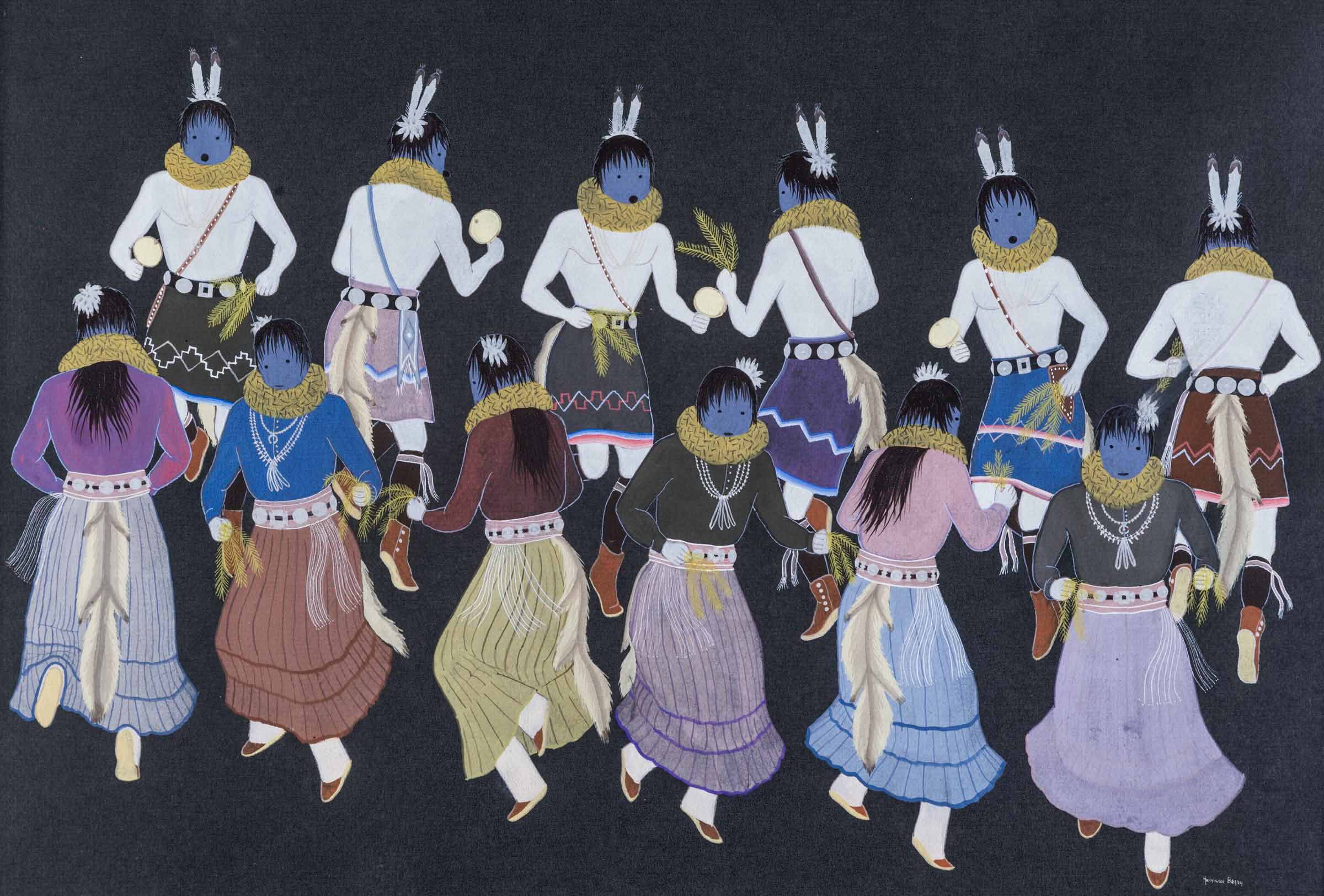Home » Special Exhibits » The Art and Artists of “The Indian New Deal” » Conjuring Ceremony
The Art and Artists of “The Indian New Deal”
Conjuring Ceremony
Another way Native artists exercised agency within the Studio Style was by telling their stories as only they could.
At First Glance
What patterns do you see in this painting?
Do you think this painting feels fast or slow?
Looking Closer
Style
This painting exemplifies the competing impulses of the Studio Style. When it was made, the paradigms of the “Indian chief” and “noble savage” dominated the American consciousness of Native peoples. Harrison Begay counters those stereotypes by depicting a unique cultural custom, the Yei Bi Chei ceremonial dance. Yet the flatness of the Studio Style—the compression of space, the linear figures, and the blank background—runs the risk of neutralizing the depiction so it reads as more of a generic illustration than a specific occurrence. Still, the dancers’ forms, each twisting in a slightly different direction, and feet, capering across the composition, breathe life into the painting. The rhythm injected into the piece shows Begay’s familiarity with the event he depicts.
As Diné (Navajo) artist, archaeologist, and anthropologist Kevin Brown explains, “Symmetry and balance are important to note in this painting because they permeate Navajo hózhó principles. This dance is balanced in terms of gender, color, positions…I hear the chants and the togetherness of the songs in this painting, which can’t be discerned unless you’re familiar with the subject matter.”
At First Glance
What adjectives would you use to describe this artwork?
What verbs would you use to describe it?
Looking Closer
Style
At First Glance
In what ways does Jose Rey Toledo adhere to the Studio Style in this painting?
In what ways does he deviate from it?
Looking Closer
Style
Unlike the other artists in this exhibition, Jose Rey Toledo learned the Studio Style not from Dorothy Dunn herself, but indirectly. As he explained to his biographer, Susan Scarberry-García, he was “discouraged” by his Albuquerque Indian School instructors from including backgrounds in his paintings, saying that he was taught that “Pueblo Indian painting was characterized by just a blank surrounding the image…that was the Indian style.”11 Shalako therefore reflects an interpretation of the Studio Style which makes room for greater representation.
While painted with a linear and two-dimensional quality, Shalako has more depth and perspective than Navajo Dance or Apache Crown Dancer. Drapery defines the space, creating a backdrop for the A:Shiwi (Zuni) ceremony, and the central figures in the foreground are painted much larger than those huddled together in the audience. It also includes more context than its counterparts in this exhibition. The dance is depicted as part of the fabric of the community—onlookers wearing everyday clothing such as collared shirts and wide-brimmed hats care for children and babies. As a result, Shalako paints a fuller picture of the dance’s dynamics and significance, weaving together its ceremonial and social qualities to create a rich cultural narrative.
Seeing Past
Context
A focus of United State colonialism has historically been repression of Indigenous religions. The post–Civil War era was the most catastrophic in this regard. In 1883, the Bureau of Indian Affairs developed the Code of Indian Offenses, also known as the Indian Religious Crimes Code, which, among other things, prohibited dances, feasts, and most activities by ceremonial singers or medicine men. Violations of the code were punishable by imprisonment. After the 1890 massacre of more than one hundred men, women, and children at Wounded Knee, which was precipitated by the spread of the Ghost Dance movement, many Indigenous religious practices were driven underground.
The Indian New Deal informally set out to reinstitute freedom of religion among Indigenous populations.
Read More
In 1934, the Commissioner of Indian Affairs and an architect of the Indian Reorganization Act, John Collier, sent a memo to all federal agencies entitled “Indian Religious Freedom and Indian Culture,” which stated that “no interference with Indian religious life or ceremonial expression will hereafter be tolerated.”12 In accordance with this shift in policy, Dunn’s students at The Studio School were encouraged to depict dances and other ceremonies in their art.
At the time, the concept of spirituality as an artistic subject was still relatively new to Native people. Then—and now—the boundaries between what is sacred and what is secular are nuanced and adaptable, with what is appropriate being resolved sometimes on the family or individual level and with the lines drawn and redrawn in different places at different points in time.




